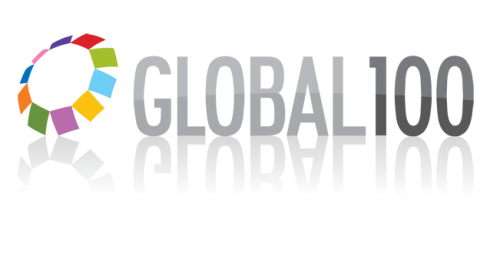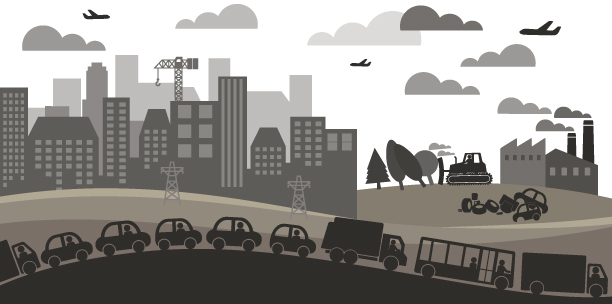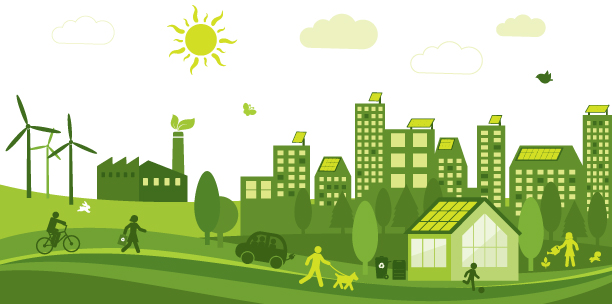Show Me the Money (It’s Green You Know)
What can behavior analysts do to help corporate America achieve a particular social good—actions that benefit the longer-term sustainability of our planet? Such actions include addressing lagging indicators (outcome metrics) such as pollution counts, airborne microwave particles, water tables, and CO2 emissions, as well as leading indicators (process or behavior change) such as buying solar panels versus relying on carbon fuels to create electricity, using less electricity during peak hours, and buying hybrid cars to save the cost and use of fuel.
In both lagging and leading indicators, the sources of change are all behavioral, whether near-term changes in patterns of behavior or redesigned technology that produces less measurable cost to the environment. Behavior is the center of the green sustainability equation. However, neither corporations nor countries involved in these global initiatives are fully alert to what that means from the perspective of the science of behavior.
Promoting the Social Good
Applied behavior analysts have long been encouraged by leaders in our field to address not only what the science can do in applied areas, but also to do work that promotes the social good of society (Skinner, 1978; Baer, Wolf, and Risley, 1968; Cooper, Heron, and Heard, 2008). In the world of autism or education or medical care, it is often easy to tie our work to a social good. In business, most practitioners do not assign a scorecard to the companies for which we work as to their green efforts. Organizational Behavior Management (OBM) practitioners are paid by corporations who have both good and bad effects on the condition of the planet. We help them with what we believe will produce socially good results. We teach workers safe habits while transporting dangerous chemicals, we help oil and gas producers do so more effectively and efficiently, and so on. We have most often defined our social good as creating positive environments for workers at all levels or in providing better resources to customers and, at times, even to the communities in which these businesses operate. The work is pragmatic. We are almost always neutral about the businesses we enter (e.g., nuclear to coal mining). We strive to create worthy performance and make the workplace a better, safer place. For OBM practitioners wanting to ensure that green effects occur, the corporate world is a complex landscape of, at times, clashing values. To take on the social good or not-so-good that emits from the corporation into the air, land, and water is new territory and offers us a different lens by which to assess ourselves as well as the corporations in which we work.
OBM practitioners are data-driven scientists trained to examine why something is done in the sense of understanding the controlling variables of phenomena. Historically we have been most effective dealing with individual change. However, many OBM practitioners are moving from a focus on individual change to arranging systems to support large-scale change across groups of individuals.
Sustainable Behavior and Sustainability
Sustainable behavior refers to fluent and recurring behavior patterns directed toward achieving desired outcomes that OBM practitioners are expected to produce for their clients and a part of any sustainability agenda. Sustainability refers to green initiative effects on preserving, renewing, and extending the use of environmental resources. To be complete, every definition of sustainability must include how to develop fluent applications of green patterns of behavior. Knowing how to achieve fluency is the sweet spot of applied behavior analysts.
The Power of Corporations to Influence our Environment
Corporations are a most powerful social/economic institution by which to influence green initiatives. Corporations are sources of great good for society. They strive to make things better, improve individual lives, create communities, and give back to the common good. They all too often make things worse, cost lives, destroy communities, and take from the common good. Some of the most disastrous actions are done by people seeking profit at all costs or by careless assessment of the importance of safe practices or in failing to reduce hazards. These actions are summed up by those affected, rightly or wrongly, as indicating a lack of concern as to how the actions impact rivers, mountains, trees, oceans, the atmosphere, and people in harmful ways. With little apparent choice, regulators move in and rules replace values-driven behavior change. Ducking the rules becomes a high-hazard game in some industries.
What Behavior Analysts Offer Corporations
Business is all about behavior, and thus choices made by corporate America to select a green over a non-green solution are decisions operating under the laws of behavior (Davison and McCarthy, 1988). For those of us who work inside corporations, we know there is often a great difference between what is said to be valued and what is actually done (say/do correlations). The great wealth that executives and stockholders amass for current decisions make competing contingencies of green initiatives that disrupt immediate financial gain, such as reductions in CO2 emissions, difficult to arrange and sustain.
Behavior is complex, fluid, and ever changing, (Skinner, 1965) and the direct relationship to individual actor A on individual actors B-Z is not a simple pattern of direct reinforcement for the outcomes desired. When in large social networks, individuals are contextually aligned rather than isomorphically aligned around desired outcomes. This is particularly true of issues that involve social constructs and value-defined actions open to individual interpretations of meaning based on one’s history of reinforcement. In other words, exact practice is difficult to ensure in the fluid and ever-changing world of large-scale social engineering. However, if it is very difficult to achieve exact patterns of behavior, it is possible to arrange the work setting to produce congruent behavior patterns leading to consistent impact on desired targets.
The values-driven component of green technology, beyond problems of definition, is related to core political and societal values around issues of responsibility and cause. The green movement is often described in terms of shoulds and oughts, and thus behaving green is about someone’s (or collective) judgment about acceptable or justifiable rules of conduct.
Tying Green to a Broad Behavioral Repertoire
If behavior analysts are to sustain green, we need to make behaving green a rewarding experience tied to a larger social mission of implementing values-based initiatives. Some would say it is about establishing the rule and reinforcing actions consistent with it. That might be necessary to initiate behavior. Green behavior requires a repertoire that sums to green and those patterns morph and change based on circumstances (the context in which behaviors occur). They are contingently shaped over time, not rule governed.
OBM practitioners are expert in how to translate desired corporate values into patterns of behavior that sum to the values targeted. We also know that judging good often occurs after the fact, when the actions can be evaluated in terms of impact, not by good intention. We know how to pair new patterns of behavior with newly created social reinforcers. We also know how to impede unbridled greed through aversive contingencies. We know how to get new patterns going through negative reinforcement and how to sustain it directionally through positive reinforcement. One example of our effect on large-scale values-driven activity is the work we do with safe practice and leadership’s decision-making to maintain a safe future across a corporation (e.g., Agnew and Daniels, 2010). However, corporations have yet to see that applying tools from the science of behavior analysis is necessary to achieving sustainability or planet-renewing green initiatives.
Evaluating Effective Corporate Practices
A declaration of our intent to develop science-based behavioral criteria for what it takes to sustain green initiatives, certifying that corporations have met the standards we set, places us at a critical place in the green movement and in our own community of practitioners. Some behavior analysts (Daniels, 2000; Cooper, 2007; Bailey and Burch, 2011) have taken a strong stand in business, in education, and in treatment as to how social values should be addressed. Skinner himself took a strong stand concerning social engineering. The Behavior Analysis Task Force on Public Policy (1988) issued a statement that is rich in taking a stand on what should be versus what is. The Cambridge Center for Behavioral Studies (CCBS) awards companies a certification for outstanding safety records. We have begun to enter this arena of defining what a company should do in relation to safety. We could do the same for companies making behavior change a part of their mission in regard to reducing harm to the environment.
Setting Sustainability Standards for Corporations
 Currently regulatory agencies oversee corporate emissions and various other indicators of green metrics as to how well companies are meeting their societal obligations. These agencies often turn to technological solutions or what they perceive as hard science related to oil and gas, mining, aerospace, energy, forestry, and other client industries. One of the most sought-after and toughest voluntary evaluators is Corporate Knights (CK), with the stated purpose of creating clean capitalism: “An economic system in which prices incorporate social, economic and ecological benefits and costs, and actors know the full impact of their marketplace actions” (www.corporateknights.com). CK publishes a list of the top 100 clean capitalist corporations in the world based on rigorous methods of identifying what is fundamental to earning a spot on the top 100. Its 11 indices include resource management, financial management, and people management.
Currently regulatory agencies oversee corporate emissions and various other indicators of green metrics as to how well companies are meeting their societal obligations. These agencies often turn to technological solutions or what they perceive as hard science related to oil and gas, mining, aerospace, energy, forestry, and other client industries. One of the most sought-after and toughest voluntary evaluators is Corporate Knights (CK), with the stated purpose of creating clean capitalism: “An economic system in which prices incorporate social, economic and ecological benefits and costs, and actors know the full impact of their marketplace actions” (www.corporateknights.com). CK publishes a list of the top 100 clean capitalist corporations in the world based on rigorous methods of identifying what is fundamental to earning a spot on the top 100. Its 11 indices include resource management, financial management, and people management.
The list was constructed by using typical measures of efficiencies in such areas as energy production, water production, greenhouse gas emissions, and waste production. Tellingly, it also used such indices as percentages of revenue paid in taxes, the ratio of CEO pay to average worker pay, and salary raises of senior executives directly linked to reductions in key performance indicators demonstrating global green concern. Finally, the list was constructed by taking into consideration innovative practices, safety production, and employee turnover.
The weights assigned to activities go beyond emission standards, to more complex relations among employees and levels of management, to sustaining employee commitment, and to examining executive pay in relation to clean capitalism investments. CK applies consequence-driven metrics to varied aspects of human behavior. Behavior analysts can learn from such directly contingent examinations of leadership decisions in relation to such issues as executive pay, levels of innovation, and employee satisfaction measures often ignored by regulatory bodies. CK provides relevant links to consequences that clearly drive broad-scale executive decisions about when and where to invest in clean capitalism.
What CK does not provide is a path to how to produce sustainable patterns of behavior required to drive sustainability initiatives. It does not require that corporations learn about the science of behavior. It does not address learning how to do a functional analysis, anticipate unintended consequences, or examine what is reinforcing or what will diminish efforts to sustain green across the corporate body. OBM practitioners can provide all of that.
Finally, the complexity of doing green and judging green, as previously mentioned, is also a question of ethics in a pluralistic society where one set of values may at times be placed against another—the good of all versus the needs of a few and so on. If we are to set up criteria by which to certify corporate efforts in doing the right thing in relation to green, we need to be modestly alert to what we know and do not know about decisions made inside companies and competing contingencies, including intended and unintended effects on workers, the larger landscape, and the economic equation. We need to consider how CK sets the spotlight on contingencies of reinforcement that are important enough to outweigh other more immediate reinforcers that enter into the equation.

Behavior analysts have powerful tools to change the moral landscape about important issues—violence, educational decay, increasing governmental effectiveness, helping the poor—broad social issues of potentially greater impact to society than what we commonly address. We need to become alert to what controls us as well as how we support or impede right actions in a world of slippery slopes and unintended consequences. But recognizing that should not dissuade us from promoting the science of behavior analysis to help corporations produce a robust future that benefits all on planet Earth.
References
Agnew, Judy and Daniels, Aubrey C. (2010). Safe by Accident: Take the luck out of safety. Atlanta, GA: Performance Management Publications.
Baer, Donald M., Wolf, Montrose M., and Risley, Todd R. (1968). Some current dimensions of applied behavior analysis. Journal of Applied Behavior Analysis, 1, 91-97.
Bailey, Jon and Burch, Mary. (2011). Ethics for behavior analysts (2nd ed.). New York, NY: Routledge, Taylor, and Francis Group.
Cooper, John O., Heron, Timothy E., and Heward, William L. (2007). Applied Behavior Analysis (2nd ed.). Upper Saddle River, NJ: Pearson.
Daniels, Aubrey C. (2000). Bringing out the best in people. New York: McGraw-Hill Companies.
Davison, Michael and McCarthy, Dianne. (1988).The matching law: A research review. Hillsdale, NJ, England: Lawrence Erlbaum Associates, Inc.
Skinner, B.F. (1978). Reflections on behaviorism and society. Englewood Cliffs, NJ: Prentice Hall.
Skinner, B.F. (1965).The Science of Human Behavior. New York, NY: The Free Press.
Task Force on Public Policy. (1988). Recommendations of the task force on public policy. The Behavior Analyst, Volume 11(1) (Spring), 27-32
i This title is from the PowerPoint presentation presented at the Behavior Change for a Sustainable World Conference in Columbus, OH, August 3-5, 2012.
Published January, 2013




